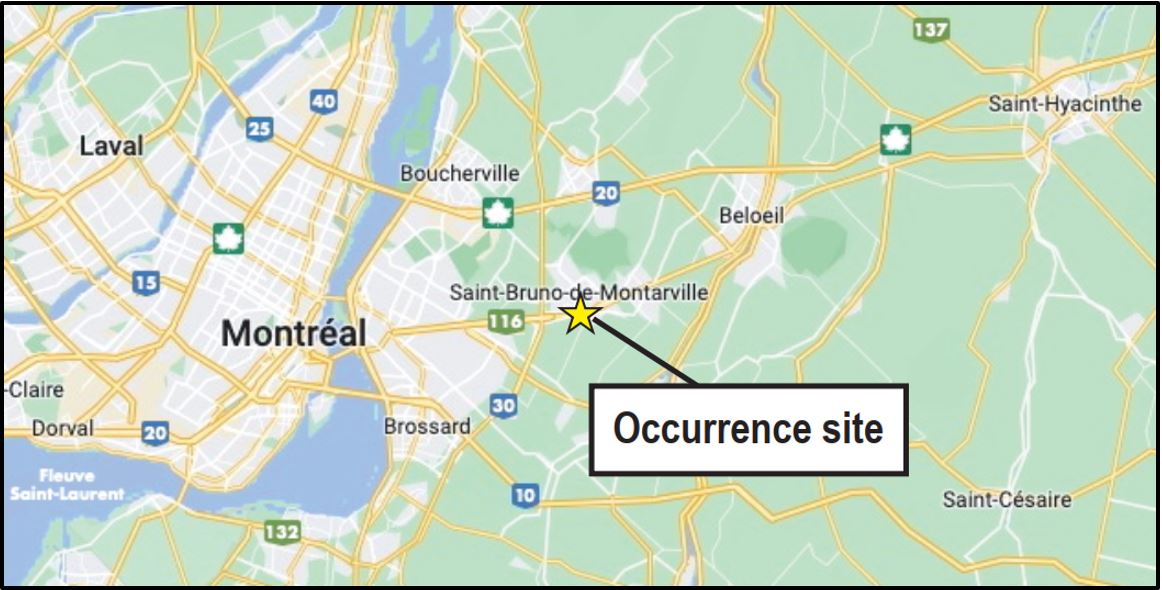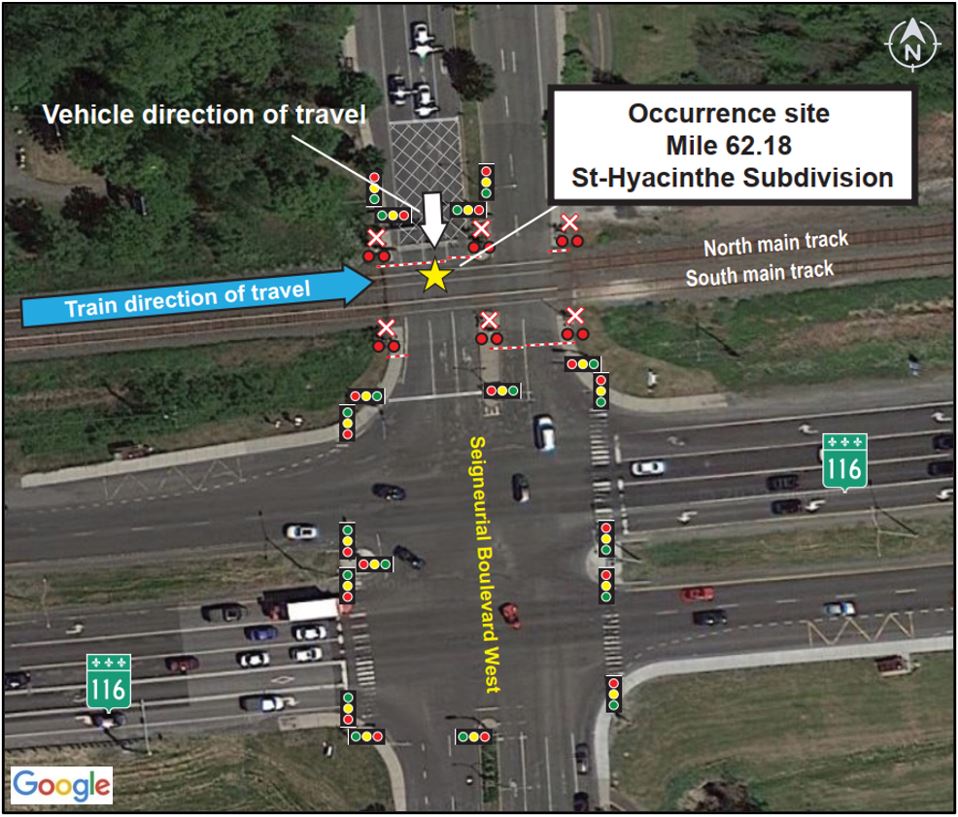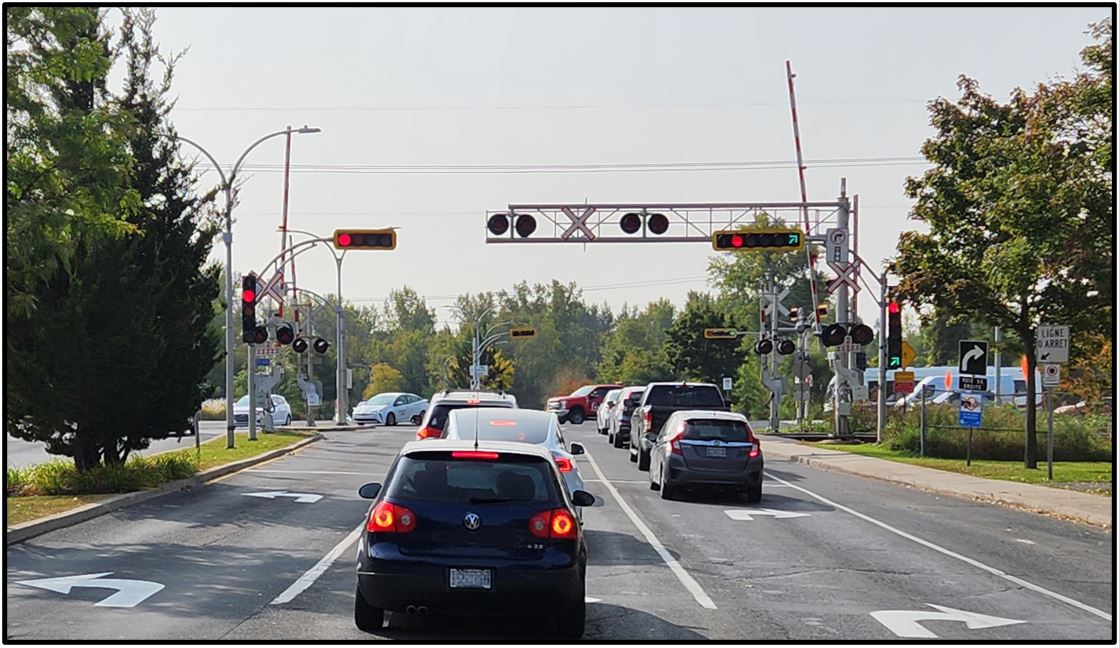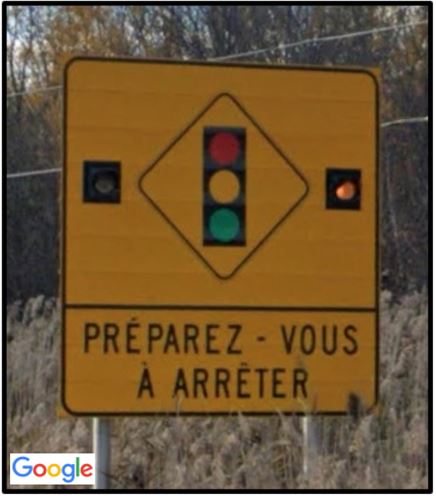Crossing collision
Réseau de transport métropolitain
Commuter train EXO 816
Mile 62.18, Canadian National Railway Company
St-Hyacinthe Subdivision
Saint-Bruno-de-Montarville, Quebec
The Transportation Safety Board of Canada (TSB) investigated this occurrence for the purpose of advancing transportation safety. It is not the function of the Board to assign fault or determine civil or criminal liability. This report is not created for use in the context of legal, disciplinary or other proceedings. See Ownership and use of content. Masculine pronouns and position titles may be used to signify all genders to comply with the Canadian Transportation Accident Investigation and Safety Board Act (S.C. 1989, c. 3).
The occurrence
On 27 January 2023, commuter train EXO 816 on the Mont-Saint-Hilaire line 13 of the Réseau de transport métropolitain (RTM), operating as exo, was travelling between Central Station, at Mile 74.25 of the Canadian National Railway Company (CN) St-Hyacinthe Subdivision in Montréal, Quebec, and Mont-Saint-Hilaire Station, Quebec, at Mile 52.4 of the same subdivision. This scheduled train, consisting of lead locomotive EXO 1358 and 6 Bombardier 3000 multilevel passenger cars, was carrying 80 passengers. The train weighed approximately 544 tons and was about 582 feet long.
The train crew consisted of a locomotive engineer (LE) and a conductorFootnote 1. The 2 crew members were qualified for their positions, met fitness and rest requirements, and were familiar with the territory.
The train, travelling east on the north main track, had just left Saint-Bruno Station (Mile 63.8) in Saint-Bruno-de-Montarville, Quebec. At approximately 1758,Footnote 2 the train was approaching the public crossing at Seigneurial Boulevard West (Mile 62.18) at a speed of 62 mph (Figure 1).
Seeing a vehicle stopped on the crossing, the LE sounded the locomotive whistle and, around 1 second later, initiated an emergency brake application. The train struck the vehicle 1 second after the brakes had been applied, at a speed of 60 mph, before coming to a stop approximately 595 m further on. The lead locomotive headlights were on full power, the ditch lights were activated, and the locomotive bell was ringing. Footnote 3
According to information gathered by the TSB during the investigation, the flashing lights on the automatic warning devices activated when the train was approximately ½ mile from the grade crossing. Three seconds later, although the grade crossing’s flashing lights were activated, the vehicle stopped on the grade crossing, its front end impinging on the rails of the north main track. A few seconds later, the driver of the vehicle tried to reverse, but the crossing gate had lowered behind her, blocking the way. Several stopped motorists sounded their horns to warn the driver.
There was no crossing gate in front of the vehicle, which remained stationary. The vehicle’s passenger intervened and asked the driver to get out of the vehicle immediately.
Five seconds before the collision, the front passenger-side door opened, and a man got out of the vehicle and took cover behind the grade crossing gate before the vehicle was struck by the train.
After the collision, several motorists came to help the vehicle driver and called emergency services. The vehicle driver was fatally injured.
Rail and road traffic were interrupted for several hours. The 80 passengers remained on board the train until they could be transferred to buses chartered by exo, around 2 hours after the collision. No one on the train was injured, and the train left the site at about 2150.
At the time of the occurrence, it was dark, the sky was overcast and the temperature was −5 °C. Visibility was good in spite of light snow showers. The wind was blowing from the west at about 5 km/h.
Site examination
The collision occurred at a public crossing equipped with automatic warning devices (flashing lights, bells, and gates) that were activated. Although the road was partly snow-covered at the time of the occurrence, it was in good condition. The vehicle was struck at the front right wheel and pushed approximately 20 m toward the northeast side of the grade crossing. The train remained on the rails and the locomotive sustained only minor damage. No fuel was spilled (Figure 2).
The track appeared to be undamaged. The automatic warning devices on the median north of the grade crossing were torn off when the vehicle was pushed by the impact.
Crossing information
The grade crossing is located in the immediate vicinity of the intersection of Route 116 Footnote 4 and Seigneurial Boulevard West Footnote 5—two high-volume roads. This intersection features a complex array of road and rail signage. The traffic lights and the grade crossing warning devices are interconnected (Figure 3).
The St-Hyacinthe Subdivision is part of CN’s main rail corridor linking Canada from east to west. In the area of the occurrence, the subdivision comprises Class 5 double tracks, which handle approximately 14 exo commuter trains, 12 VIA Rail Canada Inc. passenger trains, and 12 freight trains per day, on either of the 2 main tracks and in both directions. The authorized speed is 95 mph for passenger trains and 65 mph for freight trains.
The grade crossing is equipped with flashing red lights, electronic bells, standard reflective crossing signs, and gates with reflective strips and flashing red lights. There were bright seasonal decorations hanging from the lampposts located on the median of Seigneurial Boulevard West.
The traffic lights at this intersection are interconnected with the detection systems installed on the track. As a result, trains approaching the grade crossing are detected at least 25 seconds before the grade crossing’s automatic warning devices are activated. The traffic lights then go into advance pre-emption mode in a specific sequence to clear traffic before the grade crossing warning system is activated. One of the features of this system is that it activates the flashing yellow lights of the advance signs warning motorists on Route 116 to prepare to stop. These signs are located approximately 250 m on either side of the intersection with Seigneurial Boulevard West (Figure 4).
The crossing was compliant with the applicable Transport Canada standards. Footnote 6 All of the automatic warning devices were functional at the time of the occurrence. They were activated automatically 27 seconds before the train occupied the grade crossing. The crossing gates began lowering 4 seconds after the automatic warning devices were activated, and they were fully down 9 seconds later.
Vehicle information
The occurrence vehicle was an automatic transmission front-wheel-drive sedan. It was built in 2017. It had winter tires in good condition on all 4 wheels. The vehicle’s airbags, as well as the right-side curtain airbags, deployed during the occurrence. No mechanical defects were identified.
Vehicle occupant information
The driver of the vehicle, a woman in her eighties, was with a passenger at the time of the occurrence. She had just left her home, which was less than 4 km from the collision site. The driver was familiar with the route.
Visual and auditory clutter
When driving a vehicle, drivers must constantly focus on many elements in their visual field. When many elements are close together, there is the possibility of visual clutter, which requires more scanning to be able to fully assess the situation, a phenomenon that increases with age.Footnote 7 This can increase the driver’s reaction time.
The driver stopped inadvertently on the track when the flashing lights of the grade crossing’s automatic warning devices were activated. Several light stimuli were in the driver’s near field of vision, including the multiple traffic lights at the intersection, the illuminated decorations on the lampposts, the headlights and position lights of the many other vehicles, and the flashing lights and moving gates of the grade crossing’s automatic warning devices.
Before impact, the driver’s attention was also drawn to auditory stimuli from the horns of vehicles stopped behind her and the bells of the grade crossing.
In this occurrence, the combination of visual and audio stimuli is likely to have confused the driver, considerably slowing her reaction time and affecting her decision-making ability.
Other collisions at this grade crossing
Between 01 January 2003 and 31 January 2024, 8 collisions with trains at this grade crossing have been reported to the TSB. In 3 of these occurrences, 1 person was fatally injured. In another occurrence, 1 person sustained minor injuries. A review of each of these occurrences showed that there was no common link between them.
Every year since 2016, Transport Canada has compiled and published a list of all grade crossings in Canada, whether under provincial or federal jurisdiction, classified using the GradeXFootnote 8 tool according to risk level. According to the most recent risk ranking,Footnote 9 the Seigneurial Boulevard West public grade crossing was the 564th highest-risk crossing out of a total of nearly 25 000 listed grade crossings.
Safety message
Motorists who stop inadvertently on a grade crossing when the automatic warning devices are activated must immediately clear the track to avoid a collision. Even if the crossing gates are down and block the way, they are designed to detach when struck by a vehicle so that the vehicle can clear the track.
This report concludes the Transportation Safety Board of Canada’s investigation into this occurrence. The Board authorized the release of this report on . It was officially released on .



